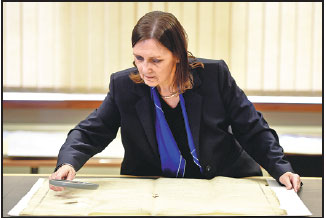US 'birth certificate' copy found in England
By Reuters (China Daily) Updated: 2017-04-29 07:02CHICHESTER, England - British experts will carry out tests to try to determine how a rare copy of the US Declaration of Independence found its way to an archive in southern England.
The handwritten manuscript, only the second such parchment in existence, had been stored for more than 60 years in a strongroom among miles of documents in the West Sussex Record Office, until its significance was revealed by Harvard University researchers Danielle Allen and Emily Sneff.
Other copies and printed versions of the Declaration exist, but the only other ceremonial parchment is the Matlack Declaration, which dates from 1776 and is kept behind glass at the National Archives in Washington.
"This document in a way raises more questions than it answers," archivist Wendy Walker said at the record office in Chichester, a small city not far from England's southern coast.
"How did it get to Sussex, how did it end up here? Behind all those questions are the questions of when was it made, where was it made, and why was it made and who was it made for?" she said.
Measuring 60 by 76 centimeters, the Sussex Declaration, as the Harvard team have called it, is thought to date to the 1780s and most likely was written in New York or Philadelphia.
The researchers believe the parchment was originally owned by Charles Lennox, the third Duke of Richmond, who was known as the "radical Duke" because he supported the colonists during the US Revolutionary War.
|
Wendy Walker, an archivist in West Sussex County, looks at a rare handwritten copy of the US Declaration of Independence in southern England on Thursday.Hannah Mckay/reuters |
- 'Cooperation is complementary'
- Worldwide manhunt nets 50th fugitive
- China-Japan meet seeks cooperation
- Agency ensuring natural gas supply
- Global manhunt sees China catch its 50th fugitive
- Call for 'Red Boat Spirit' a noble goal, official says
- China 'open to world' of foreign talent
- Free trade studies agreed on as Li meets with Canadian PM Trudeau
- Emojis on austerity rules from top anti-graft authority go viral
- Xi: All aboard internet express












